

Table of contents
- Where do the larvae come from and how do they get into the bed?
- “Clean away” larvae, but do it right
- And immediately prevent the next visit
- What can become of the larvae
- Ants, Formicidae, commonly known as house, carpenter, and garden ants
- The bread beetle, Stegobium paniceum
- Dried fruit moths, Plodia interpunctella
- Fleas, Siphonaptera
- Common woodcarid beetle, Anobium punctatum
- Khapra beetle, Trogoderma granarium
- Clothes moth, Tineola bisselliella
- Humpback beetle, Gibbium psylloides
- Mealworm, Tenebrio molitor
- Brass beetle, Niptus hololeucus
- Mold beetle, Latridiidae sp.
- Fur beetle, Attagenus pellio
- bacon beetles, Dermestidae, e.g. B. as the carpet beetle Anthrenus scrophulariae
- Conclusion
If you "get a visitor in bed", it has nothing to do with uncleanliness. Unfortunately, a lot of cleaning is still in order, the article lists the measures to catch every larva and prevent the next visit. Often that was it; only when it crawls again is it time to look for clues. A comprehensive list of household pests that produce worm-shaped larvae provides the material for that:
Where do the larvae come from and how do they get into the bed?
It is easy to answer where they come from: one of the approximately 10 to the 19 insects living on our planet has itself strayed into your apartment from the rest of the world (actively or passively, in a variety of ways, which are explained in more detail below become).
Like the insect in your bed It's a bit of a crystal ball show from an insect's point of view, but it's not very difficult (even without entomological knowledge). After the insect has crawled, flown, or been transported into your home, it will have successively engaged in the four preoccupations with which Insects usually spend their lives: eating, sleeping, reproducing, or moving from one place to another to do any of the above do.
It will hardly be worms, they have neither feet nor wings, but according to the current biological definition zero extremities (no feelers or similar). Therefore, worms can only migrate into human dwellings INSIDE pets or humans Tapeworms, roundworms, flukes, but it's about these patients for anthelmintics (wormers). not at the moment. If you have spotted "worms", they are - longer, darker - larvae that, like shorter, light-colored larvae, probably originated like this:
The immigrant insect will first have stuffed its stomach (everything edible it encountered on its way through the apartment, and that's a lot when you're very small and eats every small piece of matter of organic origin), then took a nap, only to eventually head towards the bed and bed base during its wanderings through your apartment bump. If it's a female insect or a pair (a horde?), "Mom Insect" becomes bed and bedding box immediately identify as a great nursery and in this beautiful place its eggs secluded. Now the “little ones” have been born and are on their way to … you know.
“Clean away” larvae, but do it right
Since you probably do not want to tolerate the nursery, which is so caringly laid out in the dark, warm and soft, in your bedroom, the first thing to do is vacuum, clean and wash:
- Transport bedding and duvet covers to the washing machine in a large garbage bag
- Empty the garbage bag by turning it inside out in the machine, wash everything at at least 60 °C
- Roughly vacuum the bed and surrounding area as far as you can get
- Then pick up the mattress and lean it upright against a wall that is as empty as possible
- A picture on the wall against which the mattress is leaned certainly does no harm
- But with any hasty movement, insect eggs can be "hurled around."
- A lively arrangement against wardrobes with airy slats would be e.g. B. rather clumsy if eggs/larvae of textile pests are still hanging in the cracks
- Beat out the mattress, vacuum the floor around it and the mattress on both sides
- Whole area thoroughly wet cleaned
- With basic household cleaners, e.g. B. Contain soda (sodium bicarbonate, NaHCO3, E 500ii), which also disinfects
And immediately prevent the next visit
- Succinct herbal scents help against most house pests
- Lavender, Tea Tree, Neem, Cedarwood, Camphor, Eucalyptus, etc.
- What is in the house can be used around the bed and in the bed box
- Quietly mixed, as long as the odors remain bearable for the bed users
- Drizzle onto cotton balls or scraps of fabric, distribute in the bed box and around the bed
- The use of insecticides is conceivable, but our government recommends the greatest possible restraint, because resistance only increases the problems
- In addition, you should find out more about the ingredients in each case, especially in the case of insecticides, nerve toxins that are harmful to humans are often used
Tip:
Not tolerating insect nurseries in the bedroom is one thing and a matter of course; "Freak out and preferably burn the bed" (forum post) another and possibly questionable. More information about insects or recognizing the fact that we live in a world with trillions of them (so inevitably encounter them occasionally) to reduce inflated fears. In case of doubt, help/advice should be sought before an unrealistic and unrealistic attitude leads to damage (e.g. B. threatened by long-term use of insecticides).
What can become of the larvae
If the visit of worm-shaped minis is repeated, these "insect children" must have been produced (by known means) from sexually mature, "large" insects. It is therefore important to keep an eye out for who likes to multiply in your bed box - until then adult insects “use him as a maternity hospital”, you will not be spared by the offspring remain. Where you find the adult insects and what they might be depends on the situation and bed environment. If the wooden beams of a half-timbered construction are under the bed and the larvae appear there again and again, it could be woodworms; if a little later "something flies" and a wool sweater has mysterious holes, it must be the larvae of clothes moths. Below is an overview of which insects with worm-shaped larvae like to nest in our homes, what they and their larvae look like, what they do and what to do for you:
Ants, Formicidae, commonly known as house, carpenter, and garden ants

Look: Light brown to almost black, 2.5 to 4 mm in size, eggs 1 mm, whitish larvae
Way to the house: They build nests in the surrounding area, get into the interior through cracks and crevices because they are attracted by sugar (fruit, honey, jam etc.).
Damage: No health hazard, no noticeable food losses and not unhygienic, but there are (rarely) ants eating wood and insulation material
Combat: Close larger cracks/gaps through which ant streets migrate, street possibly. redirected by sweet bait offers, otherwise normal cleaning and vacuuming
The bread beetle, Stegobium paniceum
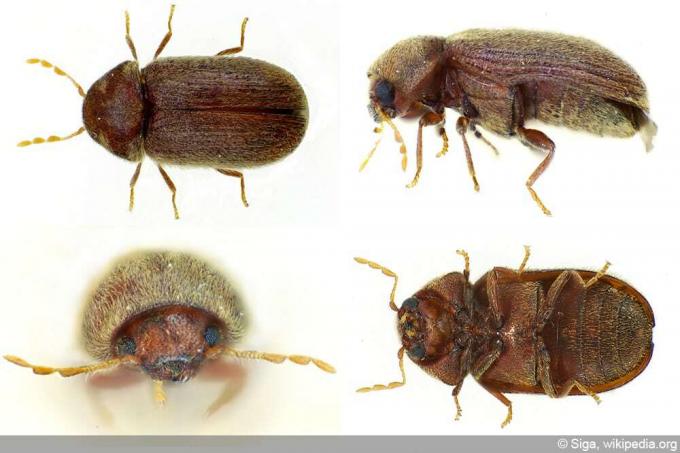
Siga, Stegobium paniceum side, edited by Hausgarten, CC BY-SA 3.0.
Siga, Stegobium paniceum front, edited by Hausgarten, CC BY-SA 3.0.
Siga, Stegobium paniceum under, edited by Hausgarten, CC BY-SA 3.0.
Look: Looks like a may beetle but tiny and brown, 2 to 3 mm in size, larvae 5 mm and white
Way to the house: Introduced with food in which the larvae develop
Damage: The infested foods, most commonly found in tea, spices, pasta, rice, cereals and dry food, and released bread beetle larvae attack paper as bookworms
Combat: Dispose of closed packaging, in additional outer packaging (due to access holes in packaging/saving the books) 1 hour Heat in the oven to over 60 °C, freeze overnight, use parasitic wasps
Dried fruit moths, Plodia interpunctella
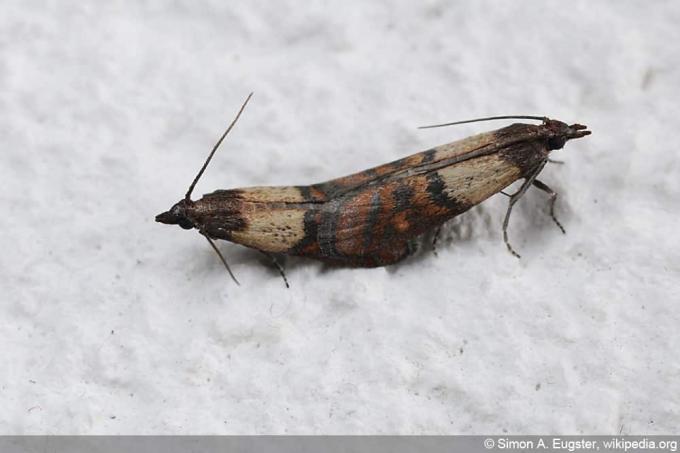
Look: Light brown in front, darker in back with stripe pattern, wingspan a good 2 cm, caterpillar (moths are butterflies) around 2 cm long
Way to the house: Is introduced with food, in which voracious caterpillars develop, white cocoons and crumbs of droppings in the supplies are also indications
Damage: Caterpillars will eat grains and pasta, legumes and nuts, chocolate and pet food, and much more that isn't protected by glass or thick-walled plastic packaging
Combat: Dispose of infested foods, repack uninfested ones into glass or plastic containers (all, otherwise you'll get the feeling that the moths are in can't get rid of in this life), vacuum cupboards thoroughly + wipe with soap solution, install sticky traps as infestation indicators and possibly. Use parasitic wasps (Trichogramma cards).
Fleas, Siphonaptera
Look: 80 mostly brown-transparent species with a length of 1-4 mm, with approx. 6 mm "huge", light-colored larvae
Way to the house: Accompanies a dog or cat or flies in from a bird's nest, larvae live in cracks and joints, mattresses and other textiles
Damage: The bloodsuckers don't stop at people and give them itchy stings and wheals, They do not transmit diseases in Central Europe, but bites tend to become infected after being scratched few
Combat: Vacuum several times a day for a week, then lay mattresses + bedding in the sun, apply anti-flea products for pets to them and spread generously in/around the infested area, spray suspicious joints with saline solution and seal briefly with adhesive tape (a few days)
Common woodcarid beetle, Anobium punctatum
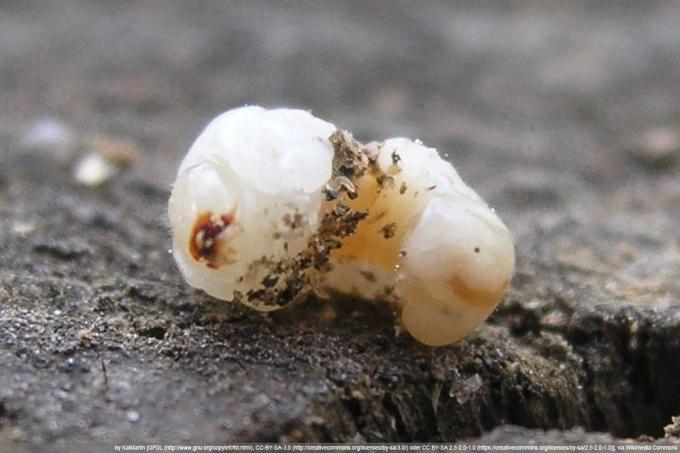
Look: Yellowish-brown, densely hairy elytra (looks like stripes), 3 to 5 mm long, larvae (known as woodworms) up to 6 mm, yellowish-white
Way to the house: No gnat beetle migrates into normally insulated and heated apartments because they can only develop well in cool, damp rooms (and there, for example, B. pews, church art or feeding boxes perforated). It can at most be carried in as an egg in antique furniture, but its absence is usually guaranteed when buying antiques.
Damage: Larvae eat their way through the wood, leaving 1 to 2 mm circular boreholes and producing wood flour trickling down (holes alone usually do not contain living larvae)
Combat: Consult an antique dealer/specialist for old wooden furniture, occasionally dispose of woodworms and the book that you bought with old books or "grill" in aluminum foil at 48 °C for 150 minutes in the oven, infested roof trusses are removed from woodworm by special hot air treatment freed
Khapra beetle, Trogoderma granarium
Look: Introduced Indian bacon beetle, which wears a kind of brown leopard skin, 2 to 3 mm in size, larvae are yellow-brown, hairy, up to 5 mm long
Way to the house: Rather annoys brewers in malt stocks of breweries, where the ideal warm and dry living conditions along with great Providing food can at most get into the household with the purchase of craft beer in a microbrewery
Damage: In the absence of malt, the larvae eat grain, rice, tea, herbs, spices, legumes and peanuts in the home
Combat: Dispose of the infected, heat in the oven to 60 °C or freeze for a few days. Vacuum pantry cupboards down to the smallest crack and wipe with tea tree oil or neem oil
Clothes moth, Tineola bisselliella

Look: Unicolored shiny light yellow to dark brown, wingspan 1 to 1.5 cm, caterpillars yellow-whitish and approx. 0.5cm long
Way to the house: Get into the house actively during the flight period from May to September or as an egg in textiles, e.g. B. after shopping in cheap shops, which are also cheaply cleaned and cared for
Damage: Larvae eat all textiles incl. Carpets and upholstered furniture, real and fake furs and feathers, otherwise neither health nor hygienic
Combat: textiles at min. Wash at 60°C, hang in the sun or freeze for a few days. Sticky traps warn of the persistence of the infestation, patchouli oil, lavender, cedar wood, neem oil keep moths away (commercially available Moth paper often contains neurotoxins that are harmful to humans), and if necessary, parasitic wasps clarify the matter continuous
Humpback beetle, Gibbium psylloides
(also called ball beetle, but this one lives in mud and gravel in the bank area)
Look: Spherical and nocturnal, shiny reddish brown, 2-3.5 mm, larvae white 3.5 mm, resemble Egerlings (larvae that were feared when people still sang "Maikäfer fleeg!")
Way to the house: Loves old buildings, v. a. their dark and moist parts, occurs rarely, but then often in abundance
Damage: Larvae and adult beetles eat animal and plant material, i.e. all kinds of food, textiles, wool, leather, upholstered furniture, organic void fillings in wooden beam ceilings
Combat: Biological control with chalcid wasps (Lariophagus distinguendus), otherwise use of liquid or dust-like contact insecticides, also in infills
Mealworm, Tenebrio molitor

Look: Black and about 2 cm in size, the larvae known as mealworms grow to approx. 4 cm long
Way to the house: The cultivar migrates in from outside or flies towards the light in the evening and prefers to stay in dark and warm places
Damage: Eat mainly flour and grain products and animal feed
Combat: Discard infested food, heat in the oven for 1 hour at 60 °C, pour boiling water over it. Terrarium owners can feed the larvae, others bring (throw) them and beetles outside, where they feed hungry birds
Brass beetle, Niptus hololeucus
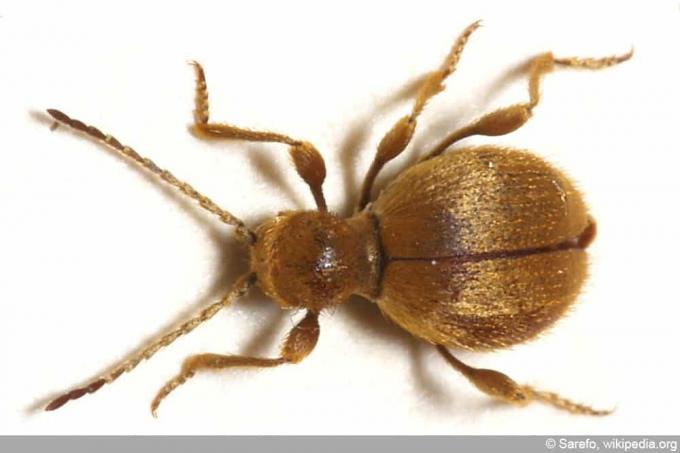
Look: Spherical, "spider-like" and nocturnal, shiny "pure brass" in dark red-brown with golden-yellow hairs, 2.5-4.5 mm, brown larva with light (hair) stripes, around 6 mm
Way to the house: Likes old buildings and half-timbered houses, nests unnoticed in nooks and crannies, often only becomes apparent during extensions or renovations when they crawl out of cavities in ceilings and floors
Damage: Eat all organic materials: textiles, leather, fur, feathers, textile wallpaper, paper, dead insects and cobwebs, but the material damage is usually small
Combat: Collect on damp cloths laid out in the evening, kill with boiling water and dispose of, Bring kieselguhr preparations or contact insecticides into the hiding places, parasitic wasps, infested ones throw away food; apply professional pest controllers to brass beetles in inaccessible places
Mold beetle, Latridiidae sp.
referred to with increasing frequency as the black mold beetle Ocypus olens
Look: Normal latridius brown to black, 0.25 to 3 mm, larvae whitish-yellow, hairy and around 3 mm long; Black mold beetle matt black and a good 2-3 cm in size, the larva looks quite similar to the beetle
Way to the house: All mold beetles live as natural decomposers, living well hidden in hay and straw, leaves and mulm of forests, but specialized in that they are mycetobiont, i.e. dependent on fungi. The small mold beetles migrate into insufficiently dried out new apartments and densely insulated but insufficiently ventilated old buildings with the formation of mold, black people Mold beetles should often be brought into the house with bark mulch from the forest, but they only stay if they have damp walls, mold spores in animal feed or the like find.
Damage: Rarely causing damage when they get into food supplies, the pests act as nature indicators to prevent the development of problematic mold infestations
Combat: Disappears when the nourishing molds die off, before there is a visible "mold problem" simply by reducing the humidity in the affected rooms. Mold beetles only die below 65% humidity, so airing and drying out damp areas is recommended here anyway. Beetles and larvae can be placed in the garden (do not touch black mold beetles, the predatory mini scorpion bites and squirts smelly liquid), where they "do their job", larvae are said to be an insider tip against slugs be
Fur beetle, Attagenus pellio

Look: Black and even covered with dense fur, 3.5 - 6 mm, golden yellow larvae a good 1 cm long
Way to the house: As a determined culture follower, it is more likely to be found around people than in the wild, and likes to fly into the house from bird nests and flowers in the garden
Damage: Eats according to the name, whereby the larvae also include stuffed animals, upholstery, woolen blankets, carpets and other textile-like materials among the furs
Combat: Have infested textiles dry-cleaned or freeze them for several days, place beetles and larvae in the garden, where they distribute nectar and pollen, or remove carcasses with fur as larvae
bacon beetles, Dermestidae, e.g. B. as the carpet beetle Anthrenus scrophulariae
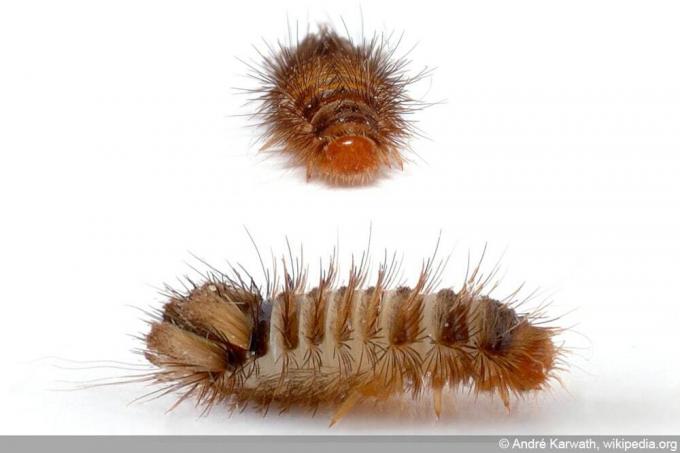
André Karwath aka Aka, Anthrenus verbasci – larva side (aka), edited by Hausgarten, CC BY-SA 2.5.
Look: Compact, rounded, mottled brown or black and approx. 1 cm long, larvae light brownish, hairy and slightly longer
Way to the house: They live all over the world and come into the house “on foot” or with groceries (pet food, etc.).
Damage: In the event of an extreme infestation, the scavengers also eat skins and wool, feathers and animal feed and can eat passages in wood or plaster
Combat: Dispose of infested, 1 hour heat in the oven to 60 °C, boil in water, have it cleaned dry, freeze for a good week, sweep up beetles and larvae after all dead insects have been eaten and throw them outside
Conclusion
If someone wants to sell products to keep insects out, the following knowledge may help you in discussing/considering the advisability of Use: From 0.1 mm, a crack or hole is large enough to let through newly hatched larvae from eggs, which the mother insect is right next to as a precaution were placed. In order to deny all insects access, you would ultimately have to shrink-wrap your furniture in a kind of nano-foil, her house and herself but then probably also it is doubtful that such measures really make the feeling of living increase. It is better to live with normal fly screens, which do not cost a lot, but occasionally let an insect through.
 Home editorial office
Home editorial office
Learn more about home pests

Red maggots / larvae in the apartment: what to do?
Red maggots in your own home are the ultimate nightmare sight. A few crippling seconds of shock are allowed. But then decisive and effective action must be taken to make them disappear. But who exactly is "the red enemy" and how is the fight fought?

Compost bin powder against maggots: this is how it works
Especially in the warm season they can hardly be avoided: maggots in organic waste. In addition to insecticides, there is a far better way to keep the annoying guests away: powdered organic waste bins. We tell you how to use it and how it works.

Combat earwigs | 5 remedies against earworms in the apartment
Although earwigs, Dermaptera in Latin, are completely harmless and actually useful animals, the insects are still a cause for panic for many people when they appear in the apartment. Here you can find out how to get rid of the unloved crawlers.

Ants in the brickwork: you can do that now
Ants are useful insects, if they are in masonry they can cause damage to an object. An infestation is not easy to recognize, but if the first signs appear, you should act immediately. Simple home remedies are usually sufficient to drive away the insects.

Identify and fight fleas in the home
Even the thought of fleas in the home is uncomfortable. After all, we associate uncleanliness with annoying insects. They are considered carriers of dangerous diseases. Where are you from? What are the signs of a flea infestation? How do you get rid of them?
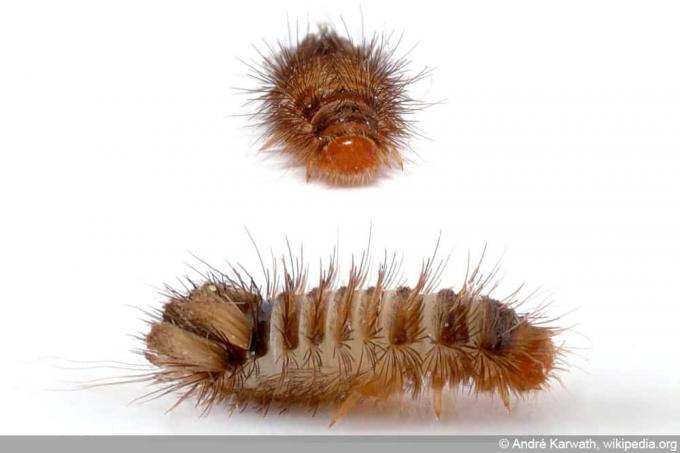
Fighting maggots on the ceiling | 7 tips for all rooms
Bedroom, kitchen or pantry, wall or ceiling - anyone who discovers maggots in the house wants to get rid of them quickly. With our help, you can do it quickly and without professional pest control.
